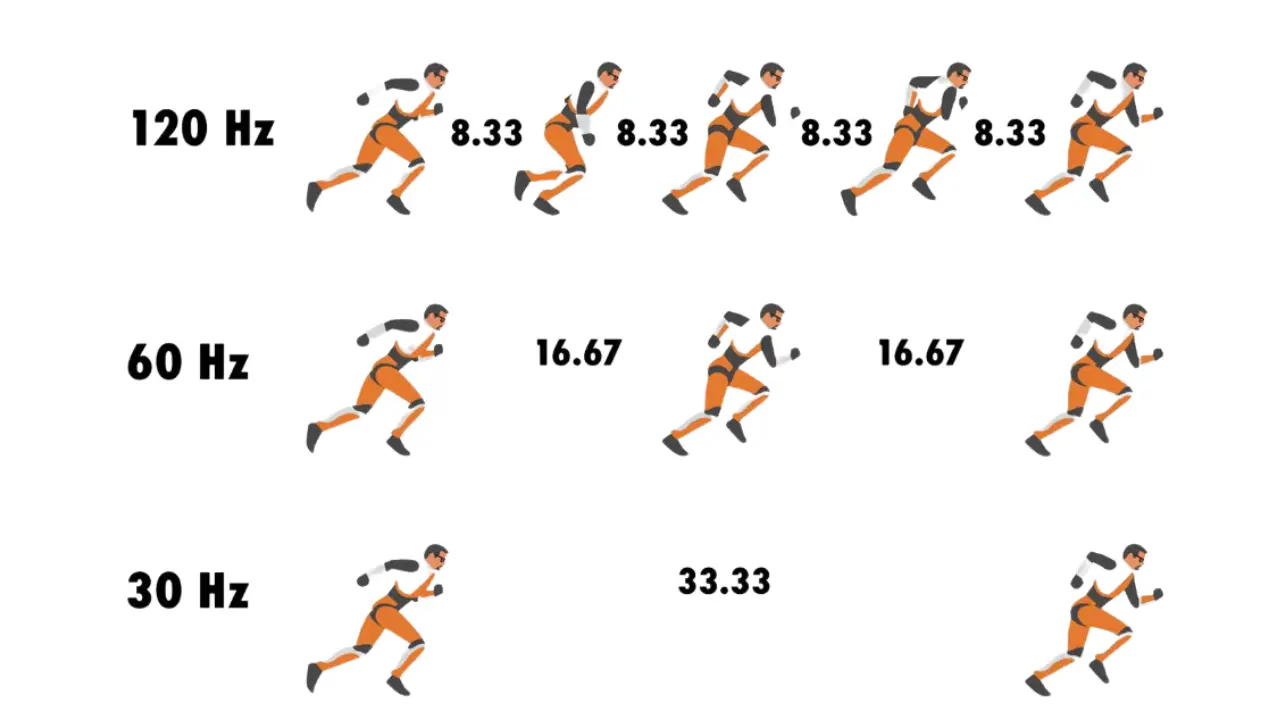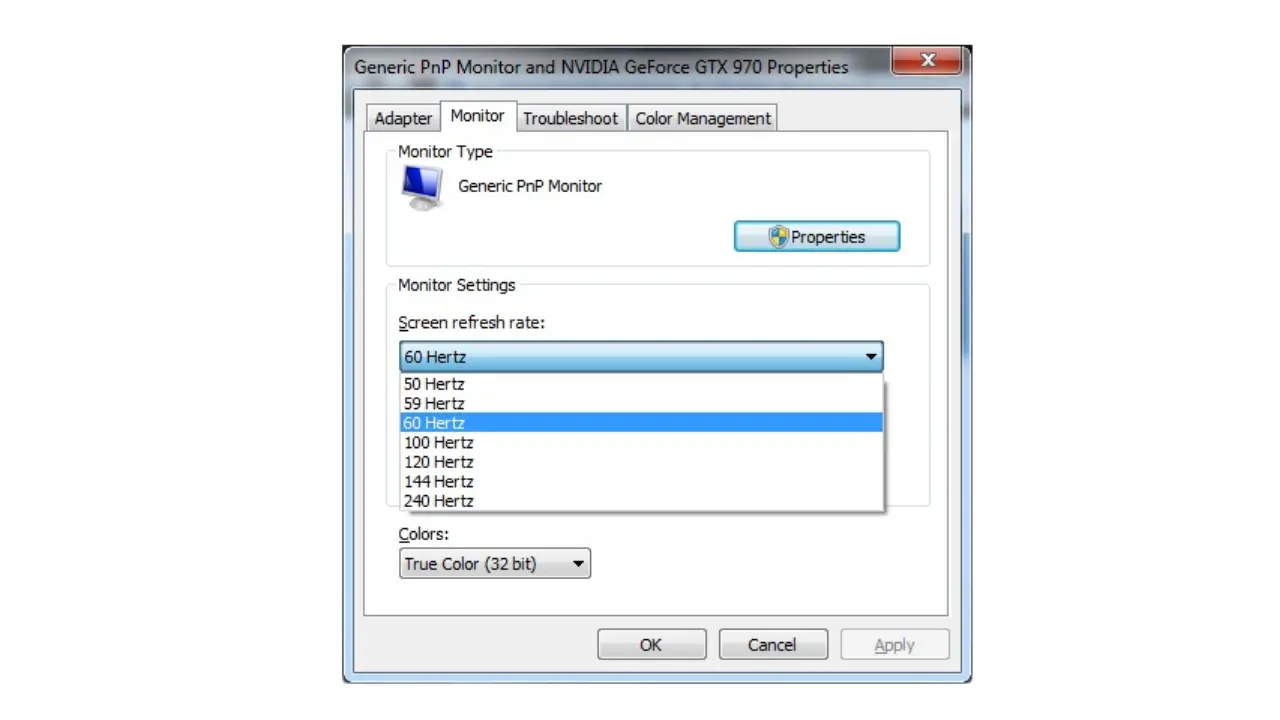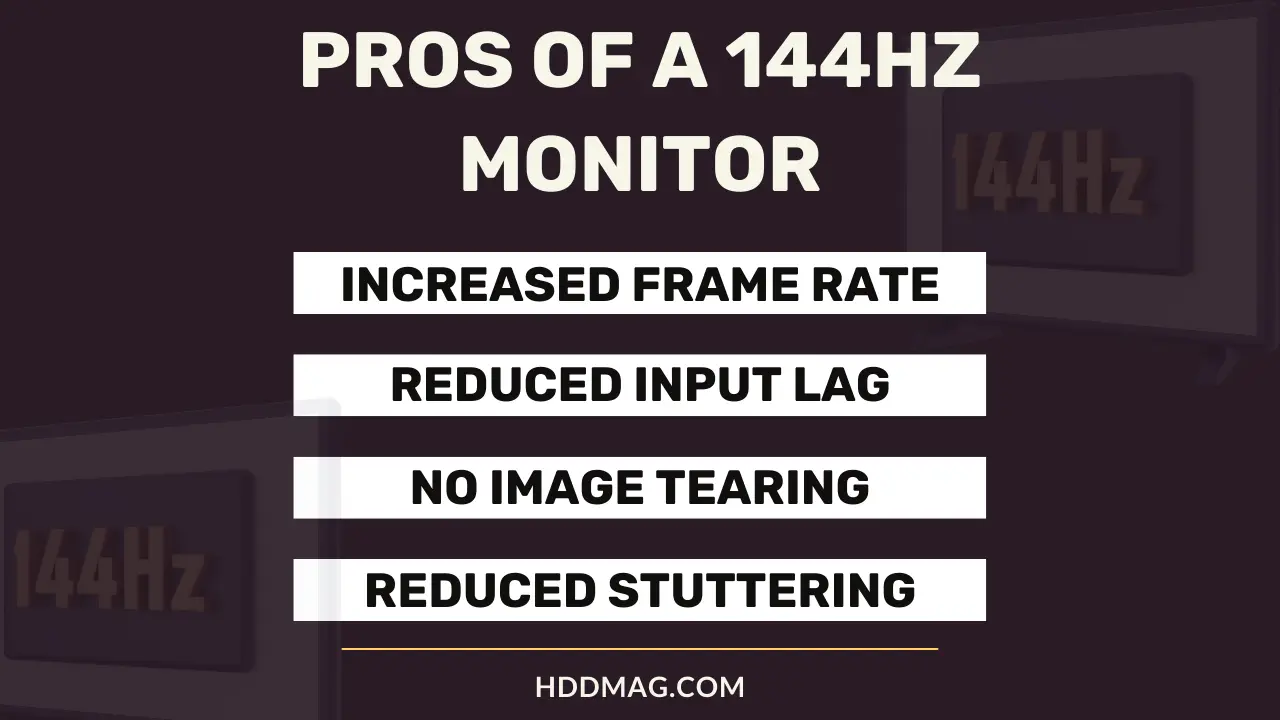144Hz vs 240Hz Monitor: Which One Is a Better Choice?

When it comes to choosing a monitor for gaming or other purposes, there are a few things to consider. The first is whether you want a monitor that operates at a standard refresh rate of 60 Hz, 144 Hz, or even 240 Hz. The second is whether you need a monitor that can output in multiple resolutions, including 1080p, 1440p, and 4K. The third thing is whether you want a monitor with wide viewing angles or one that is specifically tailored to gamers.
For many gamers, the choice between 144Hz and 240Hz monitors is a no-brainer. But what are the differences between these technologies, and which one is the best for your needs? Here’s a closer look at each option to help you decide.
What Does Hz Mean?
A Hz, or hertz, is the measure of frequency of a waveform. In regards to monitors, it usually measures how many times per second the image on the screen is updated. So, a monitor with a higher Hz rating will have a smoother image with less blur. This is important for most users because fast-moving objects on the screen will appear more clear and less jagged. Some monitors advertise their Hz rating, while others do not. If you’re looking to purchase a monitor and want to ensure you get one with a high Hz rating, be sure to check before you buy.
What Is the Standard Hz for a Gaming Monitor?
A gaming monitor is a monitor that is specifically designed for gaming. It has a higher refresh rate than a standard monitor, which allows for a smoother gaming experience. Standard refresh rates for gaming monitors are 60Hz, 75Hz, and 100Hz, but there are now also 144Hz and 240Hz monitors available. This means that the monitor can display 144 and 240 frames per second respectively.
A higher Hz allows for a smoother gaming experience, as it reduces the amount of time that is needed to render each frame. However, when choosing a gaming monitor, it’s important to consider the types of games you play to make sure you’re getting the best possible gaming experience.
Does a Higher Hz Generally Translate to a Better Monitor?
There is no definitive answer to this question as it depends on a variety of factors. However, in general, a higher Hz generally translates to a better monitor, especially for fast paced gaming. This is because a higher Hz allows for more frames per second (FPS), which results in a smoother gaming experience.

There are some exceptions to this rule, however. For example, if your graphics card cannot handle more than 60 FPS, then you will not see any benefit from using a monitor with a higher Hz. Additionally, some people find that they get headaches or feel dizzy after using monitors with high Hz rates, so many people may need to experiment to find the right rate for them.
Can an Existing Monitor’s Refresh Rate Be Increased?
Manufacturers typically list the highest refresh rate that the monitor can support. For example, a monitor may have a listed refresh rate of 60 Hz, which means that it can only display a new image 60 times per second. However, most monitors are capable of exceeding their listed refresh rates if you enable overclocking.

Enabling overclocking will vary from one monitor to another, so it’s important to consult your monitor’s manual or manufacturer’s website for instructions. If your monitor doesn’t support overclocking, there’s not much you can do to increase its refresh rate.
Can an Existing Monitor’s Refresh Rate Be Decreased?
There are some methods that can be used to increase a monitor’s refresh rate, but it depends on the make and model of the monitor. Some monitors have a built-in function that allows the user to change the refresh rate. Other monitors may require the use of a software or hardware tool.
There are however a few things to consider when decreasing a monitor’s refresh rate. One is that some monitors may not be able to support a lower refresh rate, and could potentially cause damage. Additionally, while decreasing the refresh rate can improve gaming performance for some games, it may not work for all games or graphics cards. As such, before making any changes to a monitor’s refresh rate, it is important to do some research to determine if it is safe and will provide the desired results.
How To Make the Most of Your Refresh Rate
A gaming monitor can really enhance your gaming experience, but only if you have the right settings enabled. One of the most important settings to configure on your gaming monitor is the refresh rate. This setting will determine how many times per second your monitor updates the image on-screen. The higher the refresh rate, the smoother your game will look and feel.
Most 144Hz monitors have a default refresh rate of 144 hertz (Hz), which is more than adequate for most gamers. However, if you are looking for a smoother gaming experience, you may want to consider increasing your monitor’s refresh rate. Many modern 144Hz monitors allow you to increase the refresh rate up to 180 or even 200 Hz.
Keep in mind that not all games will benefit from a higher refresh rate.
Additionally, if you don’t have a powerful computer, you may not be able to take advantage of a high refresh rate monitor. Finally, make sure your graphics card is up to par before making a purchase. Otherwise, you may just be wasting your time and/or money.
The 144hz Refresh Rate
144hz monitors are becoming more and more popular in the gaming community, and for good reason. Offering a higher refresh rate than traditional 60hz monitors, 144hz monitors can provide a smoother gaming experience by displaying more frames per second. This can be especially noticeable in fast-paced games where every frame matters.
If you’re looking to get the most out of your gaming experience, a 144hz monitor is the way to go. Keep in mind that you’ll need a powerful graphics card to take advantage of all that these monitors have to offer – so make sure to do your research before making a purchase.
Pros of a 144hz Monitor

1. Increased frame rate: 144hz monitors can display up to 144 frames per second, compared to 60fps on a traditional monitor.
2. Reduced input lag: When using a 144hz monitor, you will experience reduced input lag, which means less time between when you press a button and when the action occurs on the screen.
3. No image tearing: Traditional monitors can sometimes produce image tearing, which is when part of the image appears to be ripped or torn. A 144hz monitor eliminates this issue.
4. Reduced stuttering: When a monitor refreshes at a rate below 144hz, your graphics card has to work harder to keep up, which can lead to stutters. A 144hz monitor refreshes at a rate that is fast enough to keep up with most graphics cards, which eliminates or reduces stutters.
5. Less motion blur: A 144hz monitor results in less motion blur than a standard 60hz monitor. This is because the image on a 144hz monitor refreshes 144 times per second, as opposed to the standard 60hz monitor, which refreshes just 60 times per second. This means that the image on a 144hz monitor is updated more often, which leads to less motion blur.
6. Reduced eye fatigue: A 144hz monitor reduces eye fatigue because it refreshes the image on the screen more often. This is especially beneficial if you spend a lot of time in front of your computer.
7. More immersive: A 144hz monitor creates a more immersive gaming experience by providing a smoother image.
Cons of a 144hz Monitor
1. Higher Price Point: 144hz monitors tend to be more expensive than their 60hz counterparts.
2. Limited Compatibility: Not all games and applications support 144hz monitors, so you may need to adjust settings or use a different device.
3. Brightness: Some users find that 144hz monitors are too bright and can cause eyestrain.
4. Flicker: Some 144hz monitors flicker when used with high-end graphics card, which can cause eye fatigue.
5. Image Quality: 144hz monitors can often produce a “jumpy” image, which may not be ideal for all users.
The 240hz Refresh Rate
240hz monitors are the new hotness when it comes to gaming displays. They offer a significant improvement in motion clarity and smoothness over traditional 60hz displays, making them an ideal choice for gamers looking to get an edge on their opponents.
To take advantage of a 240hz monitor’s capabilities, you’ll need a compatible graphics card. Most high-end cards released in the past few years support at least 120hz, so chances are you’re good to go. But if you’re not sure, check with the manufacturer or your graphics card’s respective website.
Just like any other piece of hardware, there is a premium associated with 240hz monitors. Expect to pay anywhere from $300 to $500 for one of these screens. So, is it worth it? That depends on how much you value your gaming performance.
Pros of a 240hz Monitor

1. Increased frame rate and smoothness: A 240hz monitor will have increased frame rate and smoothness when compared to a 60hz or a 144Hz monitor. This is because the 240hz monitor refreshes the image on the screen more times per second, which means that there is less of a chance for the image to be distorted. This is especially beneficial for gaming, as it can help to reduce motion blur and make the action appear smoother.
2. Reduced input lag: 240hz monitors offer a number of advantages for gamers, chief among them reduced input lag and smoother motion. This can be especially important in fast-paced games where even a small amount of lag can mean the difference between victory and defeat.
3. No image tearing or stuttering: A 240hz monitor would be ideal for gaming or other activities that demand a high level of visual precision, because it produces a smooth, uninterrupted image. This is due to the monitor’s ability to refresh its image at a rate of 240 times per second, compared to the standard monitors. This means that there is no time for the image to tear or stutter, resulting in a more enjoyable experience.
4. Better color accuracy and viewing angles: A 240hz monitor will have better color accuracy and viewing angles than a 144hz monitor. This is especially important for gaming, where smooth motion and angled viewing may be key to a successful experience.
5. More responsive to mouse and keyboard movements: A 240hz monitor is more responsive to mouse and keyboard movements because it refreshes its image at a higher rate. This allows you to see any motion on the screen in greater detail and makes it easier to control your cursor or character.
6. Suitable for competitive gaming: A 240hz monitor is an excellent choice for competitive gaming. The high refresh rate allows you to see more frames per second, which means you can react faster to what’s happening on the screen. This can give you a competitive edge over opponents who are using a lower-refresh-rate monitor.
7. Affordable compared to high end gaming laptops: 240hz monitors are often more affordable than their high-end gaming laptop counterparts. They also offer many Pro features, such as a fast response time and smooth graphics. This makes them a great option for gamers who want the best possible gaming experience.
Cons of a 240hz Monitor
1. Price: They tend to be more expensive than monitors with lower frame rates.
2. Limited Availability: Not all games are optimized for 240hz yet, so you may not get the full benefit of the monitor in all cases.
3. Black Levels: They usually have worse black levels than traditional monitors.
4. Refresh Rate: Most monitor use cases are far lower than 240Hz, as such, a 240Hz monitor is only beneficial if you can actually see the difference.
5. Power Consumption: They use more power than 144Hz monitors.
So, Which Monitor Should You Go For?
144Hz monitors are becoming more popular because they offer a smoother gaming experience. They work by refreshing the image on the screen 144 times per second, which is twice as often as a 60Hz monitor. This makes fast-moving objects look smoother and helps to reduce motion blur.
240Hz monitors are even better, as they refresh the image on the screen 240 times per second. This makes them ideal for competitive gamers who need to react quickly to what’s happening onscreen. However, they are also more expensive than 144Hz monitors.
So which one should you choose?
If you’re a casual gamer who does not play high-end, fast-paced games, or you don’t mind a bit of motion blur, then a 144Hz monitor is probably a good choice. If you will be using the monitor for other things such as watching movies or working on documents, then the 144hz refresh rate may also be more than adequate.
However, if you’re a competitive gamer or you need the absolute smoothest experience possible, then go for a 240Hz monitor. The only downside is that these higher-refresh rate monitors can be expensive, and they require a powerful graphics card to take advantage of the extra frames per second.
Should You Upgrade Your 144Hz to a 240Hz Monitor?
240Hz monitors are all the rage right now. But, should you upgrade your 144Hz monitor to a 240Hz monitor? The answer is no.
First of all, 240Hz monitors are more expensive than 144Hz monitors. So, if you’re on a budget, you may not want to spend the extra money on a 240Hz monitor.
Second of all, most games don’t even support 240Hz yet. So, you won’t be able to take advantage of the increased frame rate unless the game you’re playing supports it.
Finally, even if a game does support 240Hz, you may not notice a difference in performance. Most people can only really tell the difference between 60 and 144 frames per second.
Conclusion
In conclusion, a 144Hz monitor is a better choice for most people. It has a lower price tag and it provides a good gaming experience. However, if you are looking for a monitor that can offer you even more performance and features, then a 240Hz monitor may be a better option for you. However, it is more expensive and may not be worth the investment for everyone.






